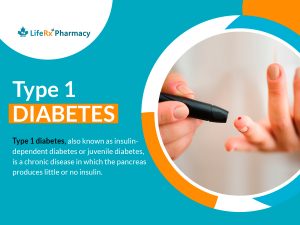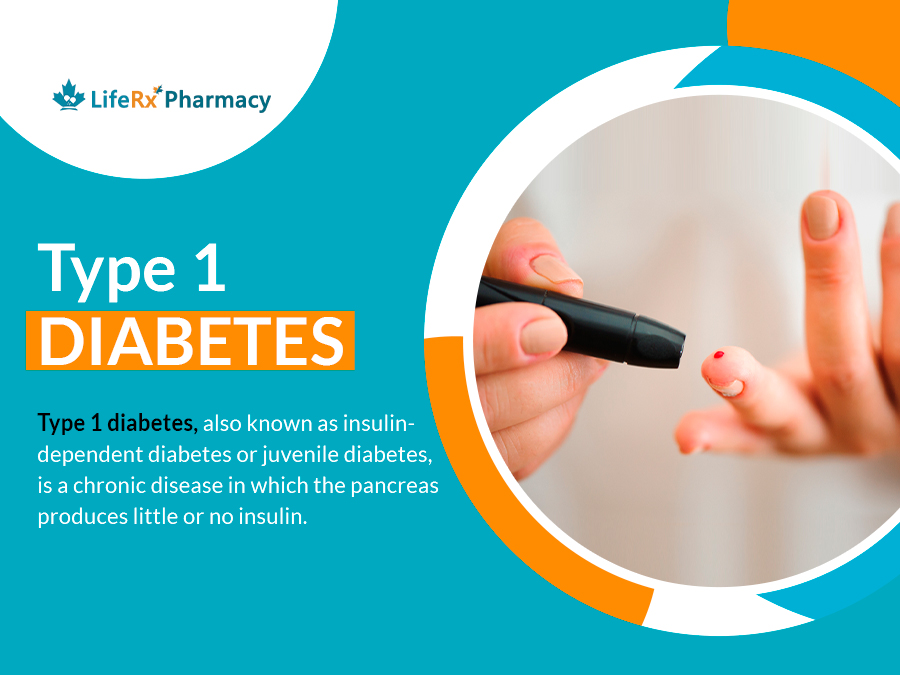Type 1 diabetes, also known as insulin-dependent diabetes or juvenile diabetes, is a chronic disease in which the pancreas produces little or no insulin.
Type 1 diabetes can be caused by a variety of factors, including genetics and viruses. Although type 1 diabetes most commonly occurs in childhood or adolescence, it can also develop in adulthood.
Despite ongoing research, there is no treatment for type 1 diabetes. To avoid complications, treatment focuses on controlling blood sugar levels with insulin, food, and lifestyle changes.
Some of the known risk factors for Type 1 Diabetes are:
- Family history: Anyone who has a parent or sibling who has type 1 diabetes is at a slightly higher risk of developing it themselves.
- Genetics: Certain genes mutation enhance the risk of developing type 1 diabetes.
- Geography: The prevalence of type 1 diabetes increases once you travel away from the equator.
- Age: Type 1 diabetes can occur at any age, although there are two distinct peaks. Youngsters aged 4 to 7 years old experience the first peak, while children aged 10 to 14 years old experience the second peak.
Signs and Symptoms of type 1 diabetes:
Symptoms of type 1 diabetes that occur suddenly include:
- Increased thirst
- Frequent urination
- Bed-wetting in children who previously didn’t wet the bed during the night
- Extreme hunger
- Unintended weight loss
- Irritability and other mood changes
- Fatigue and weakness
- Blurred vision
Complications from type 1 diabetes can affect major organs in your body.
Diabetes problems can become a serious and life-threatening disease in the long run.
- Cardiovascular Disease: Diabetes greatly increases your chances of developing coronary artery disease, which causes chest pain (angina), heart attack, stroke, arterial constriction (atherosclerosis), and high blood pressure.
- Nerve Damage (Neuropathy): High blood sugar can damage the walls of the tiny blood arteries (capillaries) that nourish your nerves. It results in tingling, numbness, burning, or pain that starts at the tips of the toes or fingers and extends upward.
- Kidney Damage (Nephropathy): Millions of small blood artery clusters filter waste from your blood in the kidneys. Kidney failure or irreversible end-stage kidney disease, which requires dialysis or a kidney transplant, can result from prolonged high blood sugar.
- Diabetic Retinopathy: Damage to the blood vessels of the retina, can result in blindness. Diabetes also increases the chance of other major visual disorders, such as cataracts and glaucoma.
- Skin and mouth problems: Diabetes can make you more vulnerable to skin, and mouth infections, such as bacterial and fungal infections. It’s also more likely that you’ll develop gum disease and have a dry mouth.
Diagnosis:
The random plasma glucose (RPG) test is the most common way for doctors to diagnose type 1 diabetes. This blood test takes a single reading of your blood glucose level. The A1C blood test is used by doctors to determine how long someone has had high blood glucose.
These tests can confirm that you have diabetes, but they can’t tell you what type it is. Because treatment differs depending on the type of diabetes, it’s crucial to know if you have type 1 or type 2.
Your health care expert tests your family members for autoantibodies because type 1 diabetes can run in families. You should undergo an autoantibody test if you have a type 1 diabetes brother or sister, child, or parent. People under the age of 20 who have a type 1 diabetes cousin, aunt, uncle, niece, nephew, grandparent, or half-sibling should also get tested.
Type-1 Diabetes Treatment :
As your body no longer produces insulin, one must take insulin if you have type 1 diabetes. Different types of insulin start working at different rates, and their effects continue for different durations of time.
Insulin can’t be given orally to control blood sugar because stomach enzymes break it down, preventing it from circulating. It will be given to you by injections or an insulin pump. Insulin can be administered in different ways like a needle and syringe, an insulin pen, or an insulin pump.

Different types of multiple daily injections of a combination of long-acting and rapid-acting insulin more closely resemble the body’s normal insulin function than earlier insulin treatments that only required one or two doses per day. Blood sugar levels have been proven to improve with a daily schedule of three or more insulin injections
The Use of the first artificial pancreas has been approved by the Food and Drug Administration for persons with type 1 diabetes who are 14 or older. It is also commonly known as Closed-loop insulin delivery.
The implanted device connects an insulin pump to a continuous glucose monitor that examines blood sugar levels every five minutes. When the monitor shows that insulin is required, the device automatically provides the necessary dose.
Prevention
One can manage diabetes by taking care of themselves regularly and by using insulin, following a diabetes meal plan, maintaining physically active, and monitoring your blood glucose levels frequently.
Exercise plays an important role in the treatment of type 1 diabetes. It helps to balance your insulin dose with the food you eat. Stress is a natural part of life, but it can make diabetes management more difficult, including controlling blood sugar levels and dealing with day-to-day diabetes care. Physical activity, sufficient sleep, muscle relaxation, regular exercises can all help to maintain controlled blood sugar levels.
Type 1 diabetes can be managed carefully to prevent the risk of major life-threatening complications. Some important suggestions are:
- Take your medications as recommended by your healthcare expert.
- Make a healthy diet and exercise a regular part of your routine.
- In case of a low blood sugar emergency, keep a glucagon kit on hand.
- Follow your annual, quarterly, or monthly regular check-ups as recommended by your doctor. During your physical examination, your doctor may also screen for diabetes-related complications as well as other medical issues.
- Maintain a healthy weight: It helps to keep your blood pressure and cholesterol under a controlled range.
- Quit smoking, tobacco, or alcohol consumption.
- Keep your immune defense system strong as diabetic patients have weakened immune systems and are prone to infection and other illnesses.
Faqs:
Is type 1 diabetes genetic?
Diabetes mellitus type 1 (DM1) is not inherited, but it owns a tendency to develop the disease which might run in families. While some persons with a family history of DM1 are more susceptible, to developing the disease.
What causes diabetes type 1?
Type 1 diabetes is caused by an autoimmune reaction (when the body accidentally attacks itself) that destroys the beta cells in the pancreas, which produce insulin. Before any symptoms develop, this process might carry on for months or even years.
Which diabetes is worse type 1 or 2?
Type 2 diabetes is usually less severe than type 1. However, it can still create severe health problems in the tiny blood arteries that go through your kidneys, nerves, and eyes. Type 2 diabetes increases your chances of developing heart disease and stroke.
What are the symptoms of type 1 diabetes?
Increased thirst, frequent urination, extreme hunger, unintended weight loss, irritability, and other mood changes. fatigue and weakness, blurred vision are a few common symptoms of type-1 diabetes.
How is type 1 diabetes treated?
Anyone with type 1 diabetes needs insulin therapy for the rest of their life. Insulin comes in a variety of forms, including short-acting (regular) insulin, long-term acting, rapid time acting, etc that works on different time durations.
How to cure type 1 diabetes permanently?
There is no prescribed treatment to cure type-1 diabetes. Although it can be easily managed and controlled with the help of insulin, medications, and a healthy lifestyle.
Reference:


